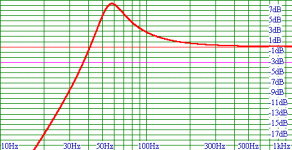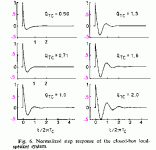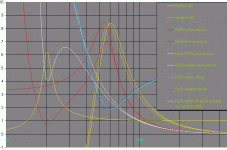My first subwoofer was made with one of the 12" paper cones !
100 litre sealed box full of fibre filler. Sounded damn good for such a cheap driver. Sounded good for movies, but not as good for music, was a bit too "slow" i guess.
I duno bout the xmax, but i was running it with my 350 watt plate amp, and it would have been taking a bit over 50 watts. The max excursion peak to peak (judged from eye, i know its pretty unscientific 😉) was probably about 4-5cm believe it or not (doubt it was linear 😉).
100 litre sealed box full of fibre filler. Sounded damn good for such a cheap driver. Sounded good for movies, but not as good for music, was a bit too "slow" i guess.
I duno bout the xmax, but i was running it with my 350 watt plate amp, and it would have been taking a bit over 50 watts. The max excursion peak to peak (judged from eye, i know its pretty unscientific 😉) was probably about 4-5cm believe it or not (doubt it was linear 😉).
Hi Graham,
I agree entirely regarding foam vs rubber, but at this price point I figured that longevity of the surround is not a big consideration.
If I was to spend $150.00+++ per woofer, I would be fully expecting infinite lifetime from the surrounds too.
As I understand it, foam surrounds are better for performance - witness Dynaudio drivers using foam surrounds.
That said my favorite woofers are all concave roll surrounds, some rubber, some doped cloth.
As I view it $26.00 or even $52.00 woofers are sort of disposable, if they break or if you can't quite get them to sound like you'd like them to, then no big loss - that would just tell you that you need to spend more, but you knew that already.
If you can get performance that satisfies, then you win all round.
I reckon impedence eq, and the right box damping can get these cheapies to work quite well enough for many apps, and ime they can be rather good regardless of the price.
Doping the cones is worth the experiment too.
Of course spending big amounts gets better materials and glues etc, but if not pushed too hard these cheaper drivers can be good value.
Good luck with it.
Eric.
I agree entirely regarding foam vs rubber, but at this price point I figured that longevity of the surround is not a big consideration.
If I was to spend $150.00+++ per woofer, I would be fully expecting infinite lifetime from the surrounds too.
As I understand it, foam surrounds are better for performance - witness Dynaudio drivers using foam surrounds.
That said my favorite woofers are all concave roll surrounds, some rubber, some doped cloth.
As I view it $26.00 or even $52.00 woofers are sort of disposable, if they break or if you can't quite get them to sound like you'd like them to, then no big loss - that would just tell you that you need to spend more, but you knew that already.
If you can get performance that satisfies, then you win all round.
I reckon impedence eq, and the right box damping can get these cheapies to work quite well enough for many apps, and ime they can be rather good regardless of the price.
Doping the cones is worth the experiment too.
Of course spending big amounts gets better materials and glues etc, but if not pushed too hard these cheaper drivers can be good value.
Good luck with it.
Eric.
Hmm... As well as the surround's normal function of holding the edge of the cone in position, does the cone when approaching breakup also start to behave like a transmission line along it's radius, the vibrations being asborbed by the lossiness of the surround? Like a terminating resistor on the end of a high speed (electronic [pulse]] transmission line preventing unwanted reflections of the pusle?mrfeedback said:As I understand it, foam surrounds are better for performance - witness Dynaudio drivers using foam surrounds.
That said my favorite woofers are all concave roll surrounds, some rubber, some doped cloth.
Hi Graham,
As has been explained to me by a speaker driver repairer colleague, the characteristics of the roll surround can be quite critical to the final sound of the driver.
The spider is critical too according to him, and the basket adds another character.
The surround indeed terminates rattle behaviours in the cone itself, and the mechanical/damping/loss and springing characteristics of the surround will influence the sound of the cone, and the overall resultant sound.
I find that foam surrounds are indeed lossy without strong springiness, and rubber surrounds sort of opposite to this.
Concave doped cloth surrounds are both lossy and non springy.
Eric.
As has been explained to me by a speaker driver repairer colleague, the characteristics of the roll surround can be quite critical to the final sound of the driver.
The spider is critical too according to him, and the basket adds another character.
The surround indeed terminates rattle behaviours in the cone itself, and the mechanical/damping/loss and springing characteristics of the surround will influence the sound of the cone, and the overall resultant sound.
I find that foam surrounds are indeed lossy without strong springiness, and rubber surrounds sort of opposite to this.
Concave doped cloth surrounds are both lossy and non springy.
Eric.
Circlotron:
The price is US$29, and is too high, I would say. What does a Peerless CSX 10 incher cost over there? Over here they are about $60, and with their long throw I am sure they move more air than this speaker, plus you can put them into a decent size box.
However, the fun is in making something out of....well maybe not nothing, but perhaps not much. So here goes.
Below is a WinISD simulation of your woofer. This assumes the actual Thiele-Small specs are as listed for these inexpensive, "no name" woofers. Of course, you're the forum expert on that subject, LOL. 🙂
Anyway, assuming the listed specs have some relationship to reality, your response in an 80 Liter box will look like the graph below.
This means that you can indeed equalize it, since you are suppressing a peak, and not trying to bring up a dip, there will be no additional amplifier power used. So your 50 watts is not used up.
Suppress that huge peak at 60 Hz, you should have something useful. F3 seems to be around 37 Hz-not so bad.
The price is US$29, and is too high, I would say. What does a Peerless CSX 10 incher cost over there? Over here they are about $60, and with their long throw I am sure they move more air than this speaker, plus you can put them into a decent size box.
However, the fun is in making something out of....well maybe not nothing, but perhaps not much. So here goes.
Below is a WinISD simulation of your woofer. This assumes the actual Thiele-Small specs are as listed for these inexpensive, "no name" woofers. Of course, you're the forum expert on that subject, LOL. 🙂
Anyway, assuming the listed specs have some relationship to reality, your response in an 80 Liter box will look like the graph below.
This means that you can indeed equalize it, since you are suppressing a peak, and not trying to bring up a dip, there will be no additional amplifier power used. So your 50 watts is not used up.
Suppress that huge peak at 60 Hz, you should have something useful. F3 seems to be around 37 Hz-not so bad.
Attachments
Watch your step (response)...
A word about "tightness" and response. The following is Richard Small's chart of step response at resonance for the following Qtc's. The Qtc of this woofer in an 80 Liter box is going to be 2.56. The chart below only goes up to Qtc=2.0. So the response of this box will be somewhat worse.
However, before you reject it, remember that even a "classic" bass reflex box, (Vas=Vb, Fs=F3), has a step response equivalent to a closed box response well over 1.0, and they sound pretty good to most people. Passive Radiator step response is usually worse, and they are found to be acceptable as well.
If I can hazard a guess, I would say that the response of this speaker in an 80 Liter box would be somehat comparable to a Passive Radiator box with a speaker of Qts=0.5, and Vb=1.5 Vas. The response might be a bit flabby, but it will be there.
As Woody Allen once said, "Eighty percent of anything is just showing up". Here, the bass will show up.
A word about "tightness" and response. The following is Richard Small's chart of step response at resonance for the following Qtc's. The Qtc of this woofer in an 80 Liter box is going to be 2.56. The chart below only goes up to Qtc=2.0. So the response of this box will be somewhat worse.
However, before you reject it, remember that even a "classic" bass reflex box, (Vas=Vb, Fs=F3), has a step response equivalent to a closed box response well over 1.0, and they sound pretty good to most people. Passive Radiator step response is usually worse, and they are found to be acceptable as well.
If I can hazard a guess, I would say that the response of this speaker in an 80 Liter box would be somehat comparable to a Passive Radiator box with a speaker of Qts=0.5, and Vb=1.5 Vas. The response might be a bit flabby, but it will be there.
As Woody Allen once said, "Eighty percent of anything is just showing up". Here, the bass will show up.
Attachments
Righto then, in the meantime I cooked up a spreadsheet showing a comparison of the expected responses of both an 80 litre sealed, and an 80 litre 20Hz 😎 reflex box. Also shown is the comparison if we equalise the response of both to flat.
Kelticwizard, yeah, that is the closed box response alright. Add a port tuned to 20Hz and look at the response. Makes you want to puke, but.... this is the approach I want to take because even though the reflex response is something to the left of tragic, unlike the sealed box version the reflex one has a HUGE capacity for handling equalisation at the very bottom end without running out of Xmax.
but.... this is the approach I want to take because even though the reflex response is something to the left of tragic, unlike the sealed box version the reflex one has a HUGE capacity for handling equalisation at the very bottom end without running out of Xmax.
Look at the 2 white curves showing the eq'd sealed and eq'd vented cone excursion for the *same* acoustic output. Also note the yellow curve that peaks at 20Hz showing that the sealed box cone excursion needs to be over =6 times= as great as the vented box version. Note again, I am talking about the driver behaviour when using an active filter before the power amp to force the acoustic output to be flat with frequency.
as great as the vented box version. Note again, I am talking about the driver behaviour when using an active filter before the power amp to force the acoustic output to be flat with frequency.
Kelticwizard, yeah, that is the closed box response alright. Add a port tuned to 20Hz and look at the response. Makes you want to puke,
 but.... this is the approach I want to take because even though the reflex response is something to the left of tragic, unlike the sealed box version the reflex one has a HUGE capacity for handling equalisation at the very bottom end without running out of Xmax.
but.... this is the approach I want to take because even though the reflex response is something to the left of tragic, unlike the sealed box version the reflex one has a HUGE capacity for handling equalisation at the very bottom end without running out of Xmax. Look at the 2 white curves showing the eq'd sealed and eq'd vented cone excursion for the *same* acoustic output. Also note the yellow curve that peaks at 20Hz showing that the sealed box cone excursion needs to be over =6 times=
 as great as the vented box version. Note again, I am talking about the driver behaviour when using an active filter before the power amp to force the acoustic output to be flat with frequency.
as great as the vented box version. Note again, I am talking about the driver behaviour when using an active filter before the power amp to force the acoustic output to be flat with frequency.Attachments
If you succed in EQ-ing out the amplitude response, the step response will follow suit. I.e if you achieve an amplitude response like a Qtc=0.707 tuning then the step response will be corresponding.
Regards
Charles
Regards
Charles
Charles:
Thanks, that is very important information. Intuitively, I would have assumed the opposite-that the wooofer has no way of knowing what the amp is emphasizes or de-emphasizes.
Good news for cheap, high Qts woofer fans!
Could it be that higher frequencies are a component of the step response, so exaggerated higher frequencies yield a flabbier response?
By the way, when I said "step response", I meant pulse response. One half sinewave at resonance frequency-not a square wave pulse. 🙂
Thanks, that is very important information. Intuitively, I would have assumed the opposite-that the wooofer has no way of knowing what the amp is emphasizes or de-emphasizes.
Good news for cheap, high Qts woofer fans!

Could it be that higher frequencies are a component of the step response, so exaggerated higher frequencies yield a flabbier response?
By the way, when I said "step response", I meant pulse response. One half sinewave at resonance frequency-not a square wave pulse. 🙂
Good news for cheap, high Qts woofer fans!
This is indeed quite old news: http://www.linkwitzlab.com/filters.htm#9
Regards
Charles
- Status
- Not open for further replies.
- Home
- Loudspeakers
- Multi-Way
- Inexpensive 12 inch paper cones vs poly and carbon fibre etc


